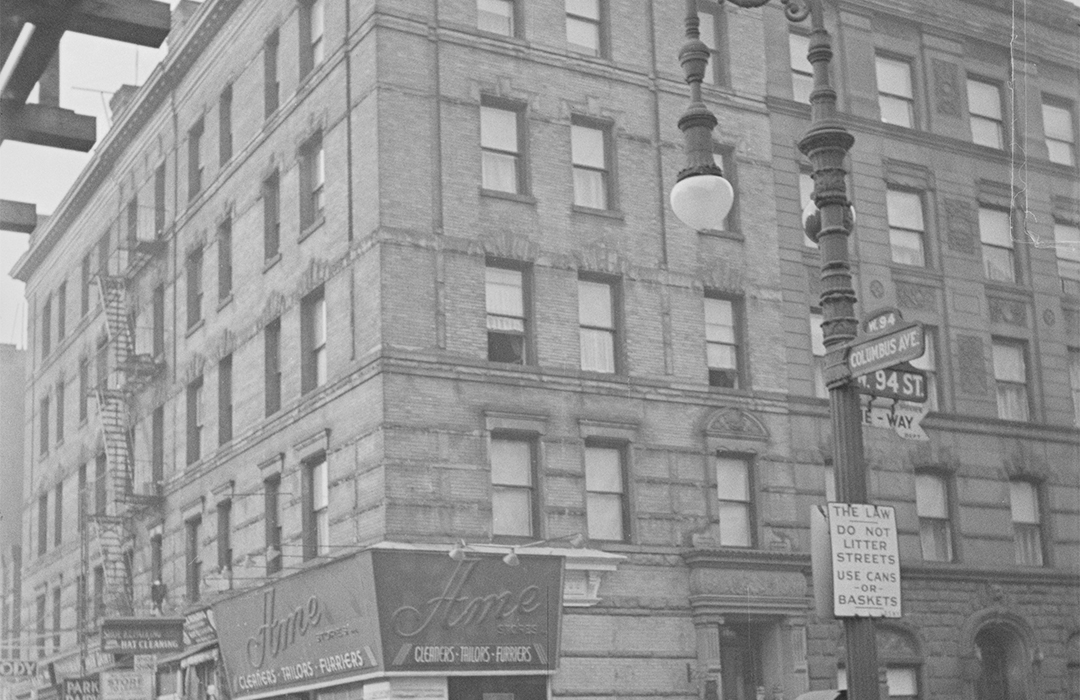
100 West 94th Street
by Tom Miller
In 1889, developers and builders Perez M. Stewart and Charles McDonald completed the construction of a five-story flat (or apartment) building at 100 West 94th Street. Faced in brownstone, its design began with Romanesque Revival at the first (where rough-cut stone and detonating voussoirs over the windows were contrasted by colorful stained-glass transoms) and second floors. The style transitioned to Renaissance Revival at the top three with elaborately carved spandrels and rondels.
Intended for upper-middle-class families, there were two apartments with seven rooms per floor, each with a bathroom. An advertisement in 1889 touted “steam heat, latest improvements, including hall boys, beautifully decorated.” (Hall boys were the uniformed staff, often teenagers, who helped with carrying packages, delivering messages, and such.) Rents ranged from $49 to $70—or just under $2,500 per month for the most expensive in 2024 terms.
The residents of 100 West 94th Street employed small domestic staffs. One of them, for instance, advertised in The World on September 6, 1890: “Nurse—Wanted, young girl living at home to mind baby during the day. Inquire Mrs. Nourse. 100 West 94th st.” The stipulation “living at home” meant that the nursemaid would not be living with the family.
Another family needed to let a servant go in the fall of 1894, possibly because they were leaving the city for an extended leave. Mrs. Wallock’s ad in the New York Herald on October 23 read, “Lady wishes situation for her girl; competent cook and laundress. Present employer, fourth floor, left. Mrs. Wallock, 100 West 94th st.”
Two months later, he found himself fighting in the Battle of Bull Run.
Mary A. and Andrew T. Anderson lived here at the time. Anderson was a bond broker with an office at 81 Spring Street. Living with the couple was an adult female—possibly a daughter or other relative. The women were planning a visit to the country at the end of the summer social season in 1895 while Andrew would be staying at home. Their detail-specific advertisement on September 12, “Wanted—Board for two ladies and their maids; rooms with southern exposure (connecting rooms only for one lady and maid) on Hudson River or New Haven R. R. (latter preferred). 30 to 40 miles from New York city; desirable location and good table. Address, giving terms and particulars, Anderson, 100 West 94th st., New York city.”
Mary Anderson died in the apartment on January 14, 1897.
Charles Oliver Fellows lived here at the turn of the century. Born in Boston on February 8, 1845, he “sought a seafaring life” as a young teen, according to historian Henry Splaine in 1911. His last voyage was from Liverpool to Boston in 1861. “On his arrival, he found his country deeply agitated by the secession of several of the Southern States and the prospect of civil war. In May 1861, one month after the first shot was fired in the Civil War, the 16-year-old Fellows joined the Union Army. Two months later, he found himself fighting in the Battle of Bull Run. He served through the war alongside his father, Colonel John Foster Fellows, leaving the army with the rank of captain on August 4, 1864.
Charles O. Fellows married Mary Ann Martin on November 27, 1867. The couple would have seven children—six girls and a boy.
Another Civil War veteran was George W. White. A somewhat tragic figure, he had been a partner in the firm of C. A. Burt & Co., which was dissolved in 1885. It is unclear what line of work he turned to, but on January 5, 1902, The New York Times reported that he had declared bankruptcy. Listing his liabilities at $16,947 and with “no assets,” the article explained, “He has a uniform of the Old Guard, valued at $25, but that is exempt.
White’s ruined finances were, perhaps, a sign of the decline of 100 West 94th Street since 1889. The days of ladies’ maids and live-in cooks were disappearing if not already entirely gone.
In 1895, Elvina Mumford gave birth to a baby boy in Flushing, Queens. She had married John Mumford at the age of 18, twelve years earlier, but the marriage was brief and quickly annulled. The newborn was the son of Lewis Mack. The baby would receive his first name from his actual father, and his surname from his mother’s long-disappeared husband. Lewis Mumford would never see either of the men.
In 1907, when Lewis Mumford was 12 years old, Elvina and he moved into “a run-down apartment house at 100 West Ninety-fourth Street,” as described by his biographer Donald L. Miller in his Lewis Mumford, a Life. According to Miller, while living here Mumford was left essentially on his own, neglected by his addicted mother. He writes:
In high school Lewis was undernourished and ill-clothed; he could not even afford to buy a new shirt once a year. His mother aged rapidly, her face became changed with suffering, and suitors stopped calling on her. Disappointed in life, and without hope for a brighter future, Elvina lapsed into a long period of invalidism, which further fueled her self-absorption. Her son was left to raise himself.
The baby would receive his first name from his actual father, and his surname from his mother’s long-disappeared husband.
Nevertheless, Mumford graduated from Stuyvesant High School in 1912 and entered the City College of New York and The New School for Social Research. Unfortunately, he contracted tuberculosis and never graduated. Lewis Mumford left 100 West 94th Street in 1918 to serve in World War I with the U.S. Navy.
Despite his difficult early years, Lewis Mumford would go on to become a brilliant literary and architectural critic, philosopher, socialist and historian. His first book, The Story of Utopias, was released four years after he moved out of 100 West 94th Street. He would serve as The New Yorker’s architectural critic for more than three decades.
Among Mumford’s neighbors at 100 West 94th Street in 1915 was Samuel Stevens. On September 9 that year, the New York Press reported, “Two additional arrests were made for alleged bookmaking at Belmont Park to-day.” One of the men was Samuel Stevens.
By the Depression years, the residents of the building were all working class. Frank Chambers lived here in 1932. The 39-year-old bachelor worked as an installer for an ice box (a non-mechanical refrigerator) company. Frank and his co-workers were installing an ice box in a house in Queens on May 16, 1932 when he, surprisingly, suffered a heart attack. The North Shore Daily Journal reported that he “died before medical aid could be summoned.”
In 1965, 100 West 94th Street and its neighbors were razed to make way for a 26-story Columbus Park Tower, completed in 1966, which engulfs the Columbus Avenue blockfront from 93rd to 94th Streets.
Tom Miller is a social historian and blogger at daytoninmanhattan.blogspot.com


